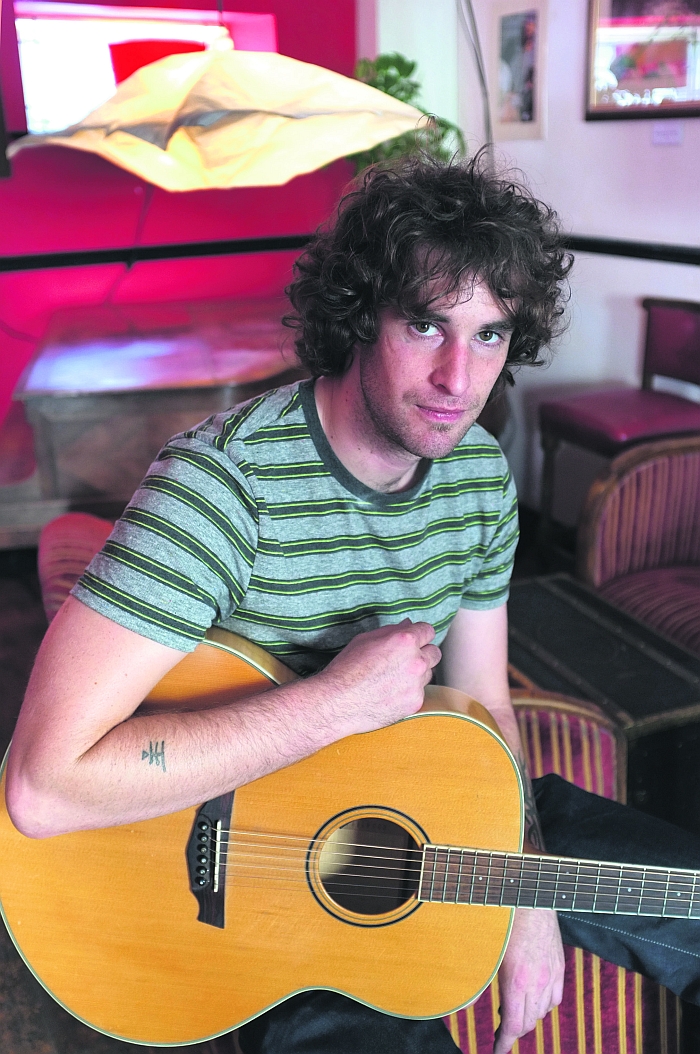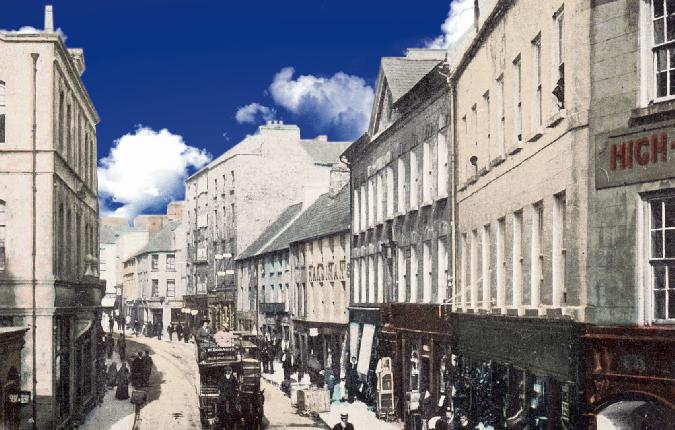Archive News
Journey from building to poetry culminates in Stephen’s debut EP

Date Published: 01-Aug-2012
Stephen James is a Galway based songwriter who released his debut EP earlier this year. His influences include Bob Dylan, Tracy Chapman and Creedence Clearwater Revival, but Stephen also puts his own spin on things. He started writing about six years ago, and hasn’t looked back since.
“I just had a mad urge one day to go writing,” he says. “I worked in construction for 10 years and it was towards the very end of that. I started writing poetry. I had a bodhrán first; I used to be mad into DJing, mad into house music and electro. I loved it, and I still have a great appreciation for it, but I don’t listen to it.”
“My sister gave me a guitar and she used to teach me chords over the phone,” he adds. “So I just started writing, and that was it; decided to give up everything else and write and play. That’s what I wanted to do.”
Stephen James’ EP was recorded out in Silver Hammer studios in Loughrea. Silver Hammer is the brainchild of Ken Keary, whom Stephen is keen to praise.
“I couldn’t rate him high enough. He just made everybody feel really at ease, and he had a class studio. Really good mics. He’s also a fantastic musician.”
The five track CD is very much a collaboration between Stephen and his band, which is: Padraic Joyce (lead guitar), Paddy Kerr (bouzouki), Tom Ricard (bass) and Terry Cooke on drums.
“I knew Joycey, Padraic Joyce, for years, vaguely,” says Stephen. “I met him on the AMP course, the Access Music Project [which runs in St.Patrick’s Bandhall Galway]. And then I met the drummer there, Terry Cooke and Tom Ricard.”
“It was me and the drummer first. We’d just go up to his house and jam out. Then we got Joycey up one day, just for a rehearsal. He started digging it. And then a friend of mine, Paddy, plays bouzouki and bodhrán.”
Having four musicians playing with him has helped Stephen to improve as a player. It also gives his EP a bigger sound, though the studio was also a new environment for the singer.
“I’d never had a band before,” says Stephen. “Prior to that I always played guitar and sang, and did solo gigs. When I started rehearsing with the band it was a whole new thing to me. Learning about dynamics.”
“And learning about the studio as well. I had to go off and spend about a week practising a technique on the microphone. Just to come back far enough when you’re singing – it’d only come to light when you’re using €2,500 mics in the studio.”
Springsteen threw an early mastered version of Born To Run into a swimming pool; in the digital era, technology allows you to tinker endlessly. But Stephen faced no such drama.
“I was glad to let the stuff go,” he says. “We did five songs on the EP and we rehearsed for about 230 hours. We rehearsed really hard; we were happy – when we went into the studio we really knew what we were doing.”
“We’d be a big rehearsal band. It was one of the things we said when we started rehearsing together, ‘if we’re going to play together we’re going to work really hard at it.’ All the lads are really focused, it’s good to be around people like that. It instils a kind of confidence in you.”
For more, read this week’s Connacht Tribune.
Galway in Days Gone By
The way we were – Protecting archives of our past

People’s living conditions less than 100 years ago were frightening. We have come a long way. We talk about water charges today, but back then the local District Councils were erecting pumps for local communities and the lovely town of Mountbellew, according to Council minutes, had open sewers,” says Galway County Council archivist Patria McWalter.
Patria believes we “need to take pride in our history, and we should take the same pride in our historical records as we do in our built heritage”. When you see the wealth of material in her care, this belief makes sense.
She is in charge of caring for the rich collection of administrative records owned by Galway County Council and says “these records are as much part of our history as the Rock of Cashel is. They document our lives and our ancestors’ lives. And nobody can plan for the future unless you learn from the past, what worked and what didn’t”.
Archivists and librarians are often unfairly regarded as being dry, academic types, but that’s certainly not true of Patria. Her enthusiasm is infectious as she turns the pages of several minute books from Galway’s Rural District Councils, all of them at least 100 years old.
Part of her role involved cataloguing all the records of the Councils – Ballinasloe, Clifden, Galway, Gort, Loughrea, Mountbellew, Portumna and Tuam. These records mostly consisted of minutes of various meetings.
When she was cataloguing them she realised their worth to local historians and researchers, so she decided to compile a guide to their content. The result is For the Record: The Archives of Galway’s Rural District Councils, which will be a valuable asset to anybody with an interest in history.
Many representatives on these Councils were local personalities and several were arrested during the political upheaval of the era, she explains.
And, ushering in a new era in history, women were allowed to sit on these Rural District Councils – at the time they were not allowed to sit on County Councils.
All of this information is included in Patria’s introductory essay to the attractively produced A4 size guide, which gives a glimpse into how these Rural Councils operated and the way political thinking changed in Ireland during a short 26-year period. In the early 1900s, these Councils supported Home Rule, but by 1920, they were calling for full independence and refusing to recognise the British administration.
“I love the tone,” says Patria of the minutes from meetings. “The language was very emotive.”
That was certainly true of the Gort Rural District Council. At a meeting in 1907, following riots in Dublin at the premiere of JM Synge’s play, The Playboy of the Western World the councillors’ response was vehement. They recorded their decision to “protest most emphatically against the libellous comedy, The Playboy of the Western World, that was belched forth during the past week in the Abbey Theatre, Dublin, under the fostering care of Lady Gregory and Mr Yeats. We congratulate the good people of Dublin in howling down the gross buffoonery and immoral suggestions that are scattered throughout this scandalous performance.
For more from the archives see this week’s Tribunes here
Archive News
Galway have lot to ponder in poor show

Date Published: 23-Jan-2013
SLIGO 0-9
GALWAY 1-4
FRANK FARRAGHER IN ENNISCRONE
GALWAY’S first serious examination of the 2013 season rather disturbingly ended with a rating well below the 40% pass mark at the idyllic, if rather Siberian, seaside setting of Enniscrone on Sunday last.
The defeat cost Galway a place in the FBD League Final against Leitrim and also put a fair dent on their confidence shield for the bigger tests that lie ahead in February.
There was no fluke element in this success by an understrength Sligo side and by the time Leitrim referee, Frank Flynn, sounded the final whistle, there wasn’t a perished soul in the crowd of about 500 who could question the justice of the outcome.
It is only pre-season and last Sunday’s blast of dry polar winds did remind everyone that this is far from summer football, but make no mistake about it, the match did lay down some very worrying markers for Galway following a couple of victories over below par third level college teams.
Galway did start the game quite positively, leading by four points at the end of a first quarter when they missed as much more, but when Sligo stepped up the tempo of the game in the 10 minutes before half-time, the maroon resistance crumbled with frightening rapidity.
Some of the statistics of the match make for grim perusal. Over the course of the hour, Galway only scored two points from play and they went through a 52 minute period of the match, without raising a white flag – admittedly a late rally did bring them close to a draw but that would have been very rough justice on Sligo.
Sligo were backable at 9/4 coming into this match, the odds being stretched with the ‘missing list’ on Kevin Walsh’s team sheet – Adrian Marren, Stephen Coen, Tony Taylor, Ross Donovan, David Kelly, David Maye, Johnny Davey and Eamon O’Hara, were all marked absent for a variety of reasons.
Walsh has his Sligo side well schooled in the high intensity, close quarters type of football, and the harder Galway tried to go through the short game channels, the more the home side bottled them up.
Galway badly needed to find some variety in their attacking strategy and maybe there is a lot to be said for the traditional Meath style of giving long, quick ball to a full forward line with a big target man on the edge of the square – given Paul Conroy’s prowess close to goal last season, maybe it is time to ‘settle’ on a few basics.
Defensively, Galway were reasonably solid with Gary Sice at centre back probably their best player – he was one of the few men in maroon to deliver decent long ball deep into the attacking zone – while Finian Hanley, Conor Costello and Gary O’Donnell also kept things tight.
For more, read this week’s Connacht Tribune.
Archive News
Real Galway flavour to intermediate club hurling battle in Birr

Date Published: 23-Jan-2013
images/files/images/x3_Courthouse.jpg










